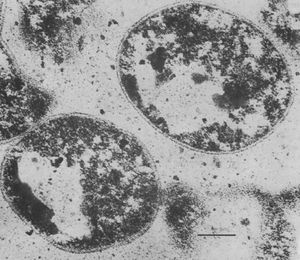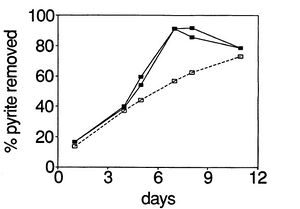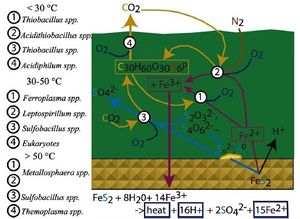Metallosphaera sedula: Difference between revisions
No edit summary |
|||
| Line 37: | Line 37: | ||
==Ecology and Pathogenesis== | ==Ecology and Pathogenesis== | ||
<i>M. sedula</i> can be found in sulfur rich hot springs, volcanic fields, and in acid mine drainage (AMD) communities. These communities are characterized by high metal ion concentrations, low pH and high temperatures. [1] [9] [10]<br><br> | [[Image:AMD1234.jpg |thumb|left|alt=alt text|Iron, Sulfur and Carbon cycling in AMB Banker and Banfield 2002]] | ||
<i>M. sedula</i> can be found in sulfur rich hot springs, volcanic fields, and in acid mine drainage (AMD) communities. These communities are characterized by high metal ion concentrations, low pH and high temperatures. [1] [9] [10]<br><br> | |||
Though the dissolution of pyrite in AMD is a natural process, it is accelerated the presence of acidophiles such as <i>M. sedula</i> that are found in these environments, thus leading to increased rates of acidification of water draining for active and abandoned mines. AMD communities are characterized by a diverse composition of microorganisms that fill available niches depending on their tolerance to temperature, metal resistance and pH. These communities display a complex symbiosis through the biogeochemical cycling of sulfur, iron, carbon and nitrogen. At high temperatures, <i>M. sedula</i> fills the niche of iron and sulfur oxidizer, a role that is filled by other acidophiles such as the mesophilic <i>Ferroplasma spp</i> and <i>Leptospirillum spp</i> at lower temperatures. [10]<br><br> | Though the dissolution of pyrite in AMD is a natural process, it is accelerated the presence of acidophiles such as <i>M. sedula</i> that are found in these environments, thus leading to increased rates of acidification of water draining for active and abandoned mines. AMD communities are characterized by a diverse composition of microorganisms that fill available niches depending on their tolerance to temperature, metal resistance and pH. These communities display a complex symbiosis through the biogeochemical cycling of sulfur, iron, carbon and nitrogen. At high temperatures, <i>M. sedula</i> fills the niche of iron and sulfur oxidizer, a role that is filled by other acidophiles such as the mesophilic <i>Ferroplasma spp</i> and <i>Leptospirillum spp</i> at lower temperatures. [10]<br><br> | ||
Revision as of 18:27, 23 April 2011
Classification
Domain: Archaea
Phylum: Crenarchaeota
Class: Thermoprotei
Order: Sulfolobales
Family: Sulfolobaceae
Genus: Metallosphaera
Species
|
NCBI: Taxonomy |
Metallosphaera sedula
Description and Significance
Originally isolated from a volcanic field in Italy, Metallosphaera sedula can be roughly translated into “metal mobilizing sphere” with the word “sedulus” meaning busy, describing its efficiency in mobilizing metals. M. sedula is a highly thermoacidophilic Achaean that is unusually tolerant of heavy metals[1].
Due it its ability to ability to oxidize pyrite (FeS2), M. sedula has the potential to be used for coal depyritization (3). With increased awareness of the environmental impact of the combustion of coals, the idea of “clean coal” was born. While there are several focuses of “clean coal”, one of which is the removal of impurities, such as sulfur found in pyrite, prior to combustion. The combustion of sulfur leads to the formation of SO2, which has adverse health effects, and contributes to acid rain [4,5].
Abiotic removal of pyrite from coal is currently the preferred method, as opposed to biotic extraction via microorganisms; however, the process is feasible. Other organisms have been studied for the purpose of coal depyritization (for example, Thiobacillus ferroxidans), however the process occurs at a slower rate than traditional abiotic removal. [6] M. sedula, being thermophilic, is tolerant of higher temperatures which result in faster extraction rates than other organisms, and a strong candidate for future use in coal depyritization [3,6].
Genome Structure
Describe the size and content of the genome. How many chromosomes? Circular or linear? Other interesting features? What is known about its sequence?
Cell Structure, Metabolism and Life Cycle
M. sedula is a cocci, roughly 1um in diameter with pilus-like structures protruding from its surface when viewed via electron microscopy [1].
M. Sedula is an obligate aerobe that grows best at 75C and pH 2.0 [1]. The high level of physiological diversity it displaces is relatively unique amongst extremophiles. It is capable of heterotrophic growth using complex organic molecules (with the exception of sugars [1]), autotrophic growth by the fixation of carbon dioxide in the presence of H2 through an proposed modified 3-hydroxypropionate cycle [8], and its highest rates of growth are seen when grown mixotropically on casamino acids and metal sulfides [2].
The dissimilatory oxidation of iron and sulfur in M. Sedula, driven by its membrane oxidases, is key to M. sedula’s ability to mobilize metals and bioleach. When grown in the presence of H2, the ability of M. Sedula to leach copper from chalcopyrite (CuFeS2), is reduced [7].
Ecology and Pathogenesis
M. sedula can be found in sulfur rich hot springs, volcanic fields, and in acid mine drainage (AMD) communities. These communities are characterized by high metal ion concentrations, low pH and high temperatures. [1] [9] [10]
Though the dissolution of pyrite in AMD is a natural process, it is accelerated the presence of acidophiles such as M. sedula that are found in these environments, thus leading to increased rates of acidification of water draining for active and abandoned mines. AMD communities are characterized by a diverse composition of microorganisms that fill available niches depending on their tolerance to temperature, metal resistance and pH. These communities display a complex symbiosis through the biogeochemical cycling of sulfur, iron, carbon and nitrogen. At high temperatures, M. sedula fills the niche of iron and sulfur oxidizer, a role that is filled by other acidophiles such as the mesophilic Ferroplasma spp and Leptospirillum spp at lower temperatures. [10]
References
1. Huber, G. ,Spinnler, C. , Gambacorta , A., and Stetter, K. “Metallosphaera sedula gen. and sp. nov. Represents a New Genus of Aerobic, Metal-Mobilizing, Thermoacidophilic Archaebacteria”. Systematic and Applied Microbiology. 1989. p. 38-47.
2. Auernik, K., and Kelly, R. “Physiological Versatility of the Extremely Thermoacidophilic Archaeon Metallosphaera sedula Supported by Transcriptomic Analysis of Heterotrophic, Autotrophic, and Mixotrophic Growth”. Applied and Environmental Microbiology. 2010. p. 931-935.
3. Clark, T., Baldi, F., And Olson, G. “Coal Depyritization by the Thermophilic Archaeon Metallosphaera sedula”. Applied and Environmental Microbiology. 1993. p. 2375-2379.
4. http://www.epa.gov/oaqps001/sulfurdioxide/
5. http://www.epa.gov/acidrain/what/index.html
6. Peeples, T.L., and Kelly, R.M., “Bioenergetics of the metal/sulfur-oxidizingextreme thermoacidophile, Metallosphaera sedula”. Fuel. 1993. p. 1577-1752.
7. Auernik, K and Kelly, R. “Impact of Molecular Hydrogen on Chalcopyrite Bioleaching by the Extremely Thermoacidophilic Archaeon Metallosphaera sedula”. Applied and Environmental Microbiology. 2010. p. 2668-2672.
8. Alber, B., Kung, J., and Fuchs, G. "3-Hydroxypropionyl-Coenzyme A Synthetase from Metallosphaera sedula, an Enzyme Involved in Autotrophic CO2 Fixation". Journal of Bacteriology 2008. p. 1383-1389
9. http://genome.jgi-psf.org/metse/metse.home.html
10. Baker, B., and Banfield, J. "Microbial Communities in Acid Mine Drainage". FEMS Microbial Ecology. 2002. p. 139-152
Author
Page authored by Stephanie Napieralski and Caitlin Miller, students of Prof. Jay Lennon at Michigan State University.
<-- Do not remove this line-->




